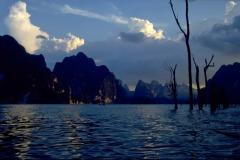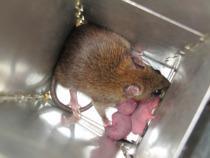
Chiew Larn Reservoir is surrounded by Khlong Saeng Wildlife Sanctuary and Khao Sok National Park, which together make up part of the largest block of rainforest habitat in southern Thailand (> 3500 km2). Photo: Antony Lynam
One of the perennial and probably most controversial topics in conservation ecology is when is something “too small’. By ‘something’ I mean many things, including population abundance and patch size. We’ve certainly written about the former on many occasions (see here, here, here and here for our work on minimum viable population size), with the associated controversy it elicited.
Now I (sadly) report on the tragedy of the second issue – when is a habitat fragment too small to be of much good to biodiversity?
Published today in the journal Science, Luke Gibson (of No substitute for primary forest fame) and a group of us report disturbing results about the ecological meltdown that has occurred on islands created when the Chiew Larn Reservoir of southern Thailand was flooded nearly 30 years ago by a hydroelectric dam.
As is the case in many parts of the world (e.g., Three Gorges Dam, China), hydroelectric dams can cause major ecological problems merely by flooding vast areas. In the case of Charn Liew, co-author Tony Lynam of Wildlife Conservation Society passed along to me a bit of poignant and emotive history about the local struggle to prevent the disaster.
“As the waters behind the dam were rising in 1987, Seub Nakasathien, the Superintendent of the Khlong Saeng Wildlife Sanctuary, his staff and conservationist friends, mounted an operation to capture and release animals that were caught in the flood waters.
It turned out to be distressing experience for all involved as you can see from the clips here, with the rescuers having only nets and longtail boats, and many animals dying. Ultimately most of the larger mammals disappeared quickly from the islands, leaving just the smaller fauna.
Later Seub moved to Huai Kha Khaeng Wildlife Sanctuary and fought an unsuccessful battle with poachers and loggers, which ended in him taking his own life in despair in 1990. A sad story, and his friend, a famous folk singer called Aed Carabao, wrote a song about Seub, the music of which plays in the video.
One good thing that became of this tragedy was the birth of a grassroots conservation organisation, Seub Nakasathien Foundation (SNF), which mobilises people through social media to question government policies on the environment, especially big dam and infrastructure projects that affect important wildlife areas. SNF were successful in stopping the Nam Choan Dam from being built inside Huai Kha Khaeng, and currently they are trying to stop the Mae Wong Dam from being constructed inside Mae Wong National Park. Mae Wong is one of two last remaining large watersheds in Thailand that are yet to be dammed. The other is Mae Yom in northern Thailand.”
Obviously, Seub lost the battle and Chiew Larn was born. But it wasn’t just the flooded forest and drowning wildlife that resulted. Nearly 30 years later, the islands created by the dam have lost nearly all of their native mammal species.
Making the best of a bad situation, the creation of the dam provided an amazing opportunity to study extinction dynamics. The entire mammal fauna was surveyed on 16 islands varying in size from 0.3 to 56.3 hectares both 5-7 and 25-26 years post-flooding.
What we report in today’s article is rather disturbing. In the < 10-ha islands, the mammal species almost all went extinct within 5 years, and within 25 years in the bigger fragments.

Malayan field rat (Rattus tiomanicus). Normally found in villages and agricultural areas, R. tiomanicus has invaded forest islands and apparently displaced native small mammals. It is a good coloniser, being able to cross open stretches of water or other inhospitable habitat, and also has rapid generation times – and was even observed giving birth inside the traps. These traits could partly explain its success in Chiew Larn Reservoir. Photo: Luke Gibson
We also developed an island biogeographic model of the extinction process, which revealed a rather amazing result. It was the biggest islands that lost their species faster than the smallest. Possibly exacerbated by the invasive Malayan field rat, the average time to lose half of an island’s biota (estimated over all islands) was only 14 years, with the biggest islands losing species faster.
This might be a case of ‘the rich having more to lose’, and that being ‘big’ doesn’t really help if island (fragment) area is substantially below some critical threshold beyond which it behaves more like ‘mainland’ communities. In other words, size didn’t matter within the range of fragment areas available – all mammal species were committed to extinction regardless.
It’s a sobering result, and certainly demonstrates the absolute necessity of keeping large fragments intact in disturbed landscapes.
Armed with this conclusion, one could argue that small fragments have no value. I don’t think this is the case, because we didn’t examine smaller taxa such as birds, reptiles, amphibians, insects, plants or fungi. While something might be better than nothing for many taxa, in the case of mammals at least, you need big areas, even for relatively small species to have any chance of persisting. Not only that – it demonstrates that fragmentation can result in catastrophic extinctions within less than a few decades, so any restoration efforts must occur quickly.
Anytime someone argues that a few fragments is enough to do the job, just show them this study. ‘Big’ is essential if we want any hope of maintaining biowealth into the future.
Thanks to Luke ‘Cookin-with-Gas’ Gibson, Tony ‘Tiger’ Lynam, Fangliang ‘Fang’ He, Dave ‘Bickie’ Bickford, David Woodruff, Sara Bumrungsi and of course me old mate, Bill ‘Fragmentation’ Laurance.
CJA Bradshaw

